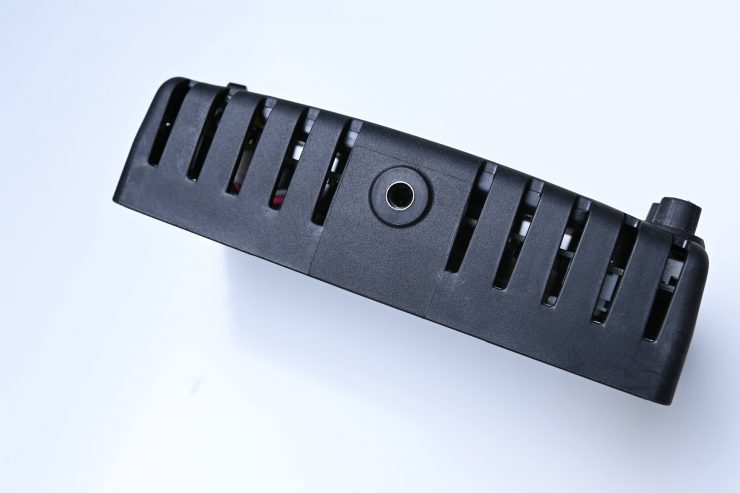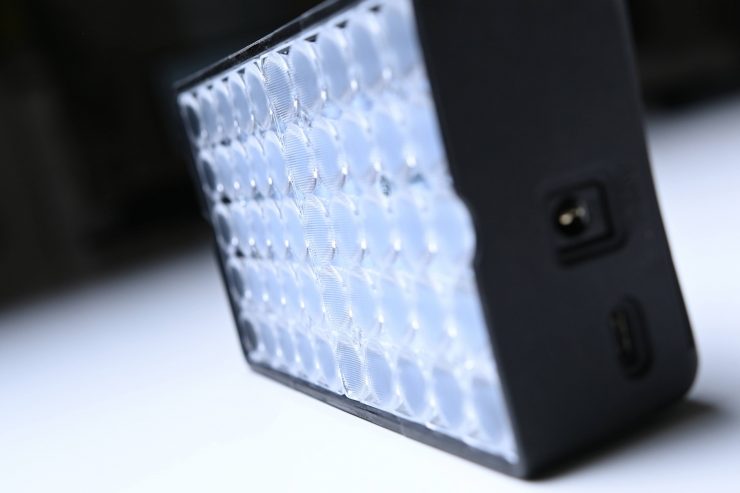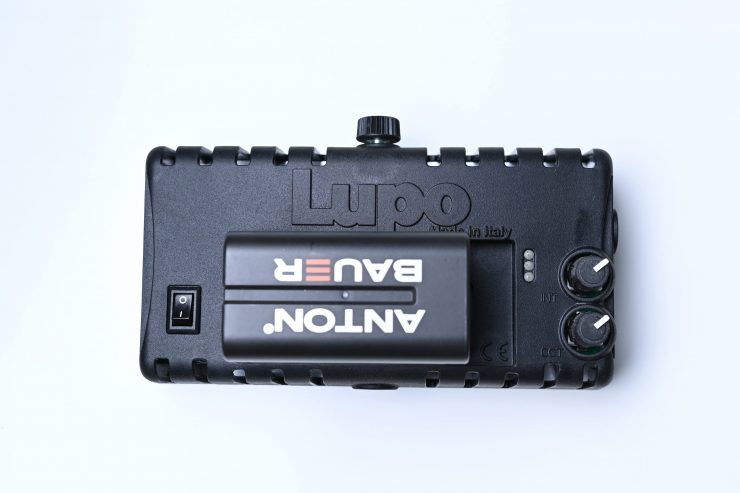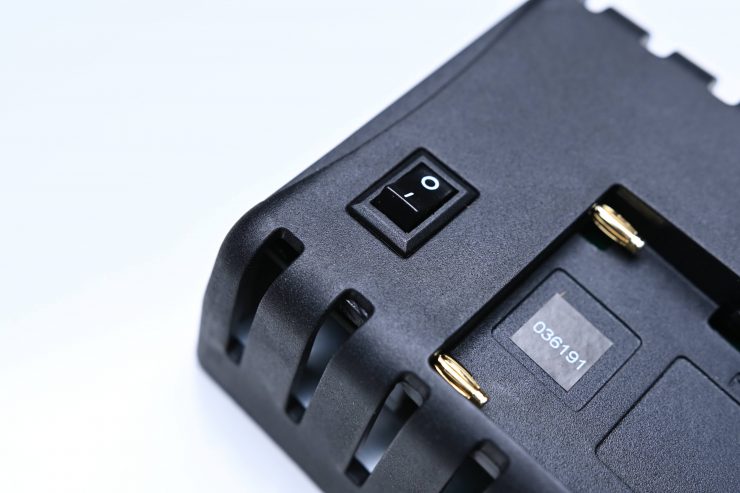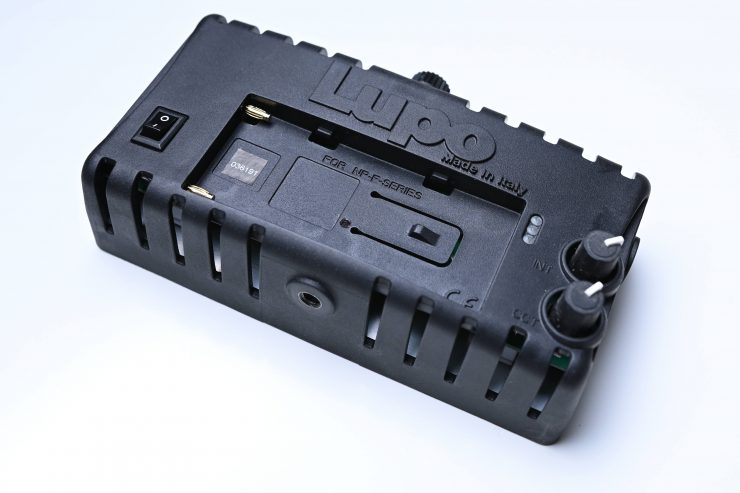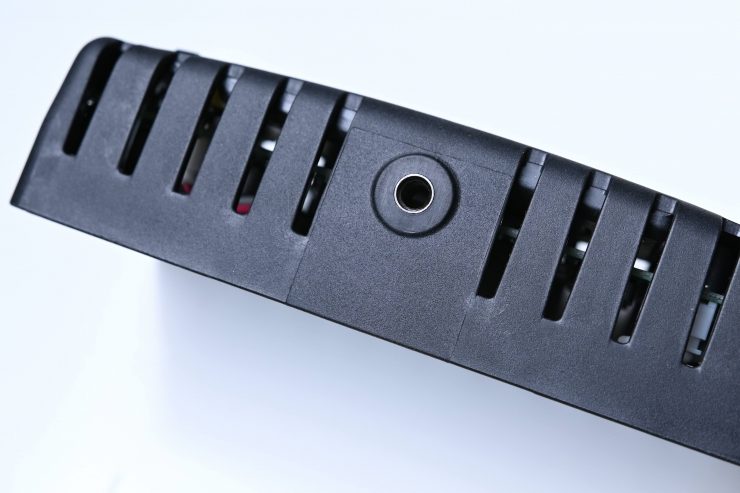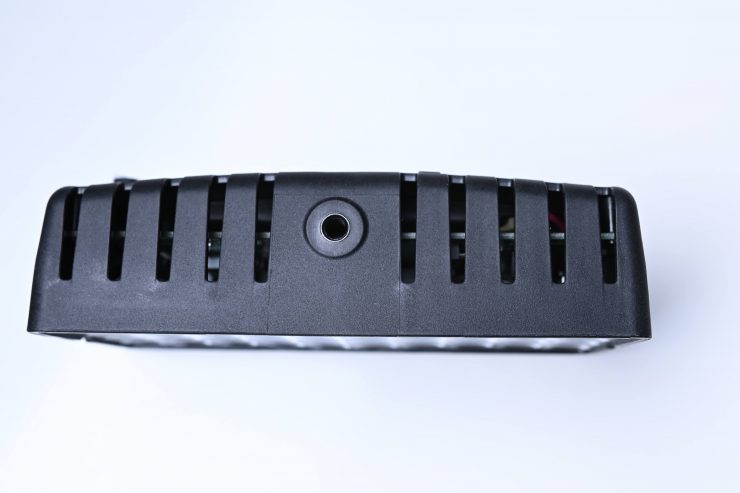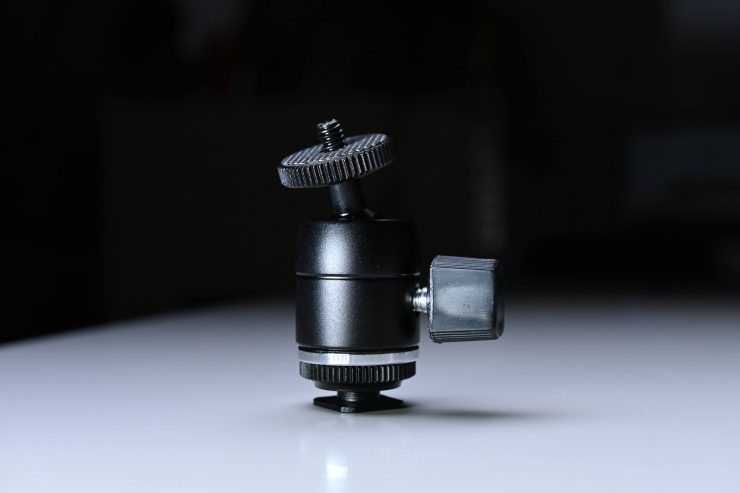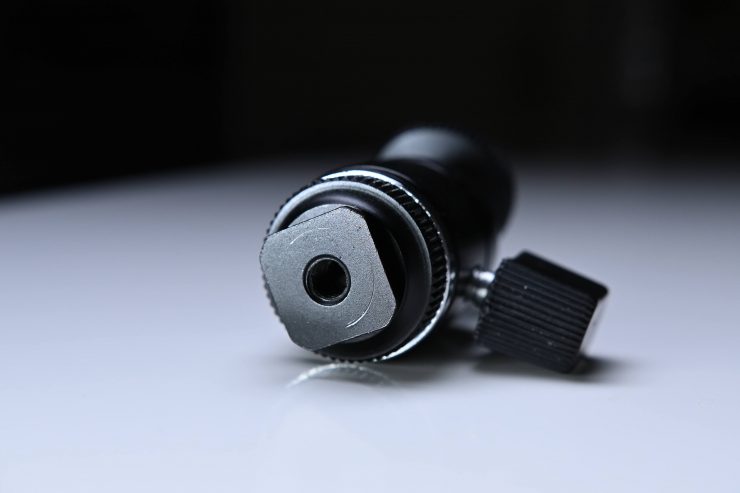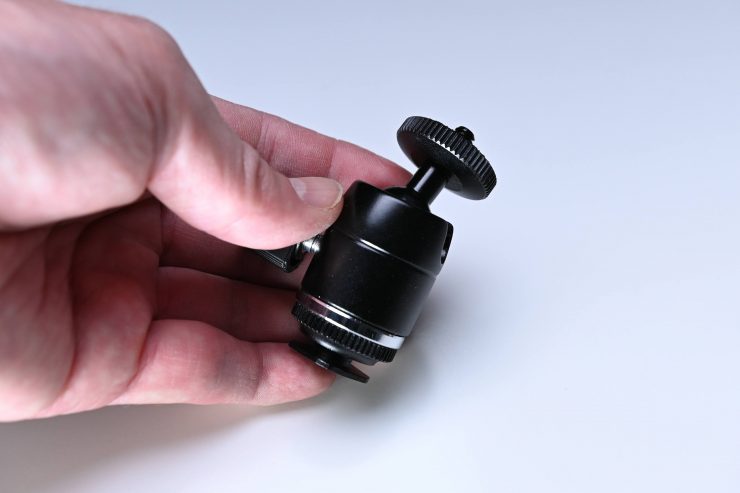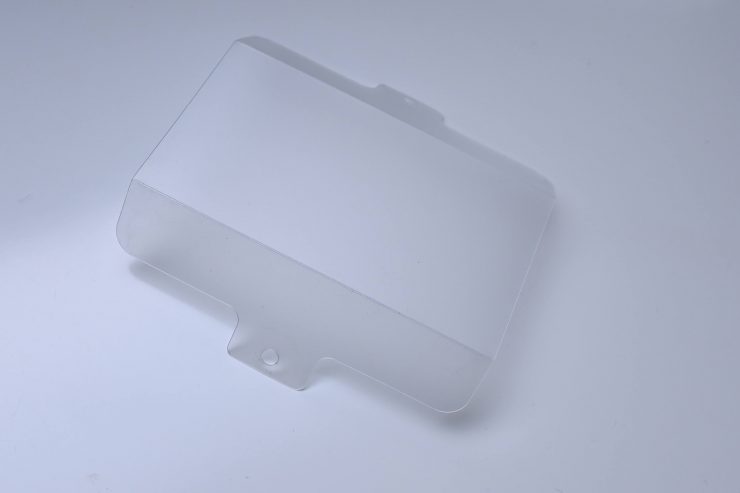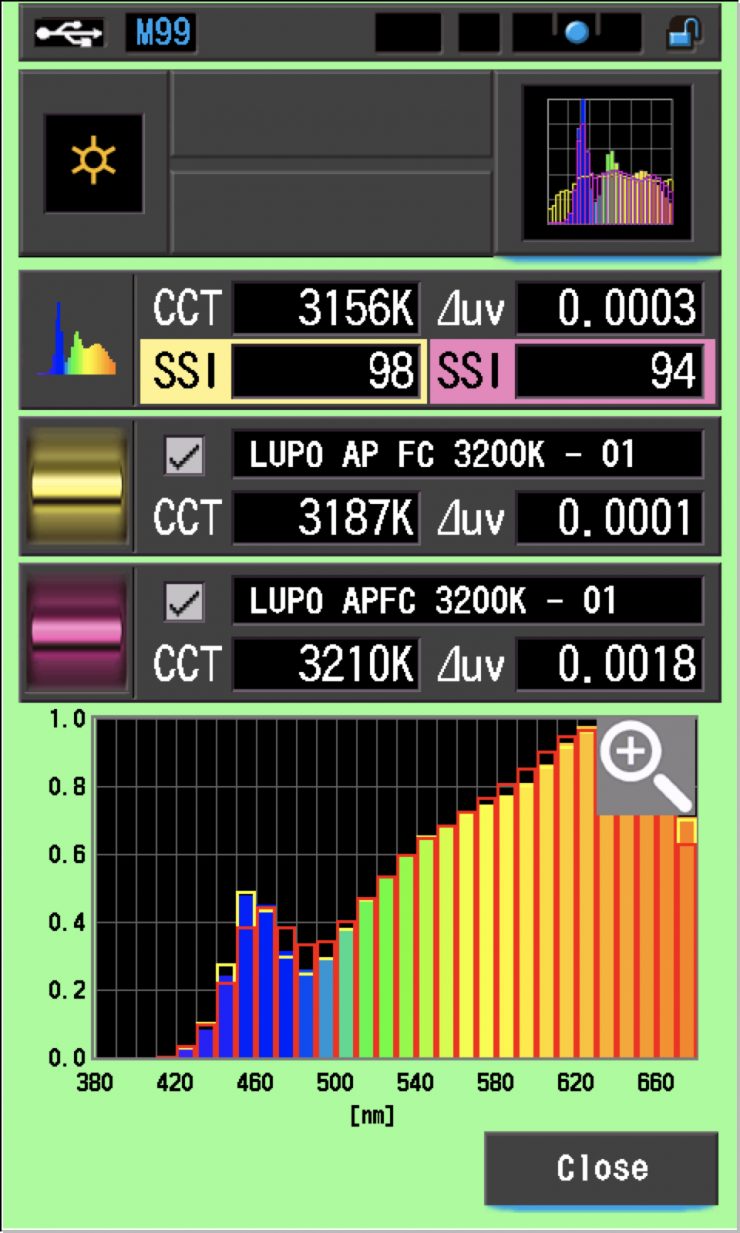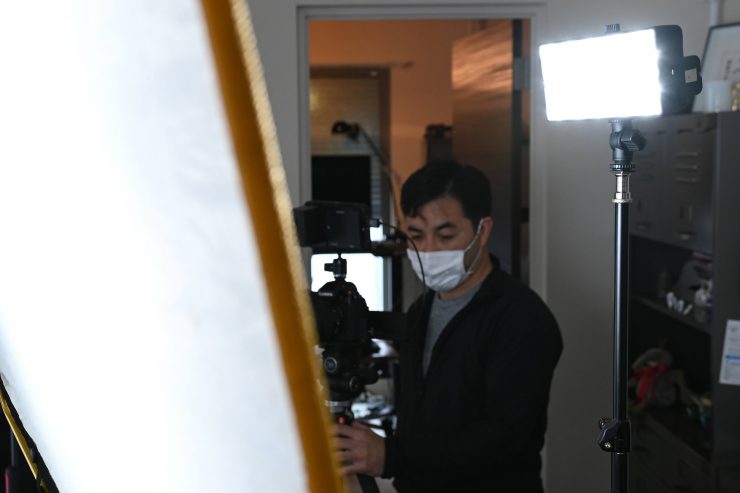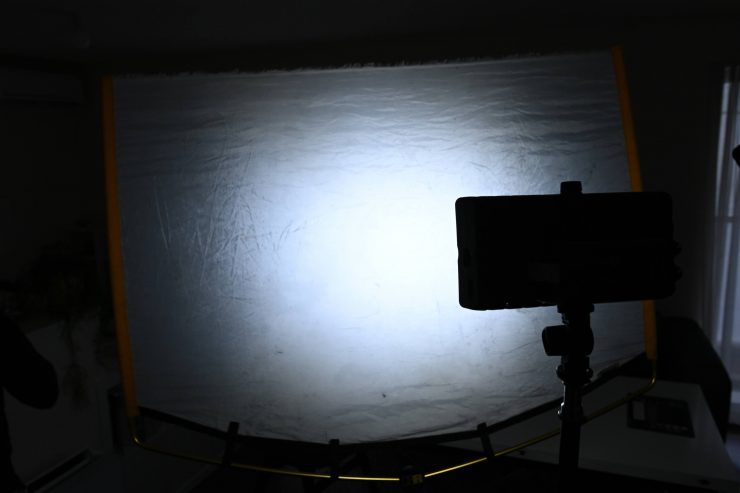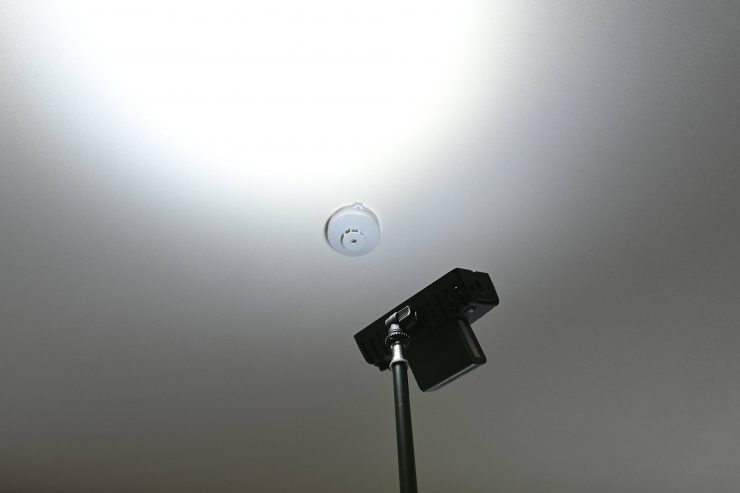
The Lupo Smartpanel is a powerful on-camera light that has a claimed output of 4200 Lux at 1m. That is more than quite a few 1×1 panels on the market output.
Lupo claims that the Smartpanel is the most powerful on-camera light on the market.
With its small size and low power draw the Smartpanel could be used as a mini studio light, a compact travel lighting solution, or for just about any other purpose you can think of.
Lupo has garnered a good reputation for making high quality, affordably priced LED lights that have a very high output, and the Smartpanel looks to continue that tradition.
I have reviewed quite a few Lupo lights on the site, and they have always impressed me as fixtures that strike a good balance between price and performance. So let’s see if that trend continues.
A mini mini Superpanel?
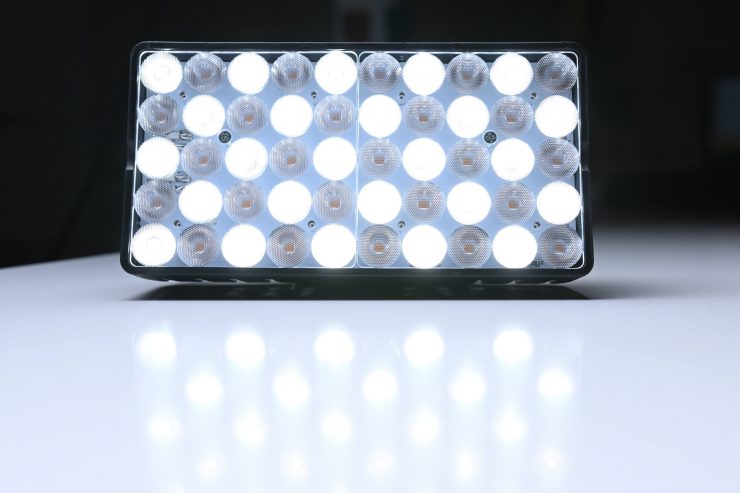
Up until now, Lupo has mainly made larger sized fresnel and 1×1 and 2×1 fixtures. Recently they released the Actionpanel, which I have just reviewed, and now they have the even smaller Smartpanel.
With more and more shooters using smaller cameras and trying to keep the weight and size of all of their equipment to a minimum, there is a real need for powerful, smaller sized lights. Downsizing usually involves making compromises, especially when it comes to lights.
There are plenty of on-camera style lights out there in the market, but most of them have a pretty limited output which only makes them suitable for certain applications.
I’m interested to find out if the Smartpanel bucks that trend and whether it is versatile enough to be used for other applications.
Weight & Dimensions
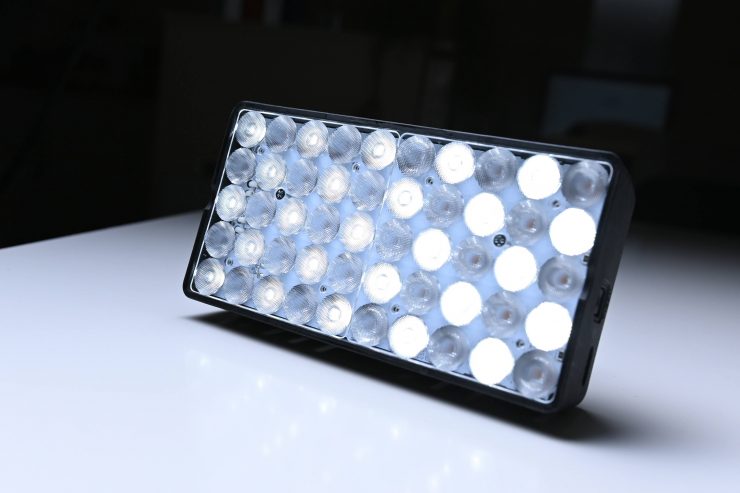
The Smartpanel Dual Color has physical dimensions of 150 x 40 x 85 mm and weighs in at just 300g (0.6 lb).
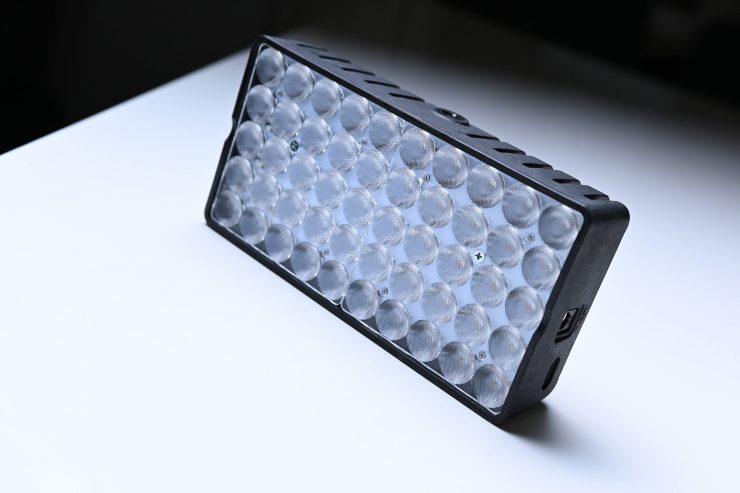
Its small size means you can easily fit a few in a small bag and always keep them with you. In an emergency situation you could also use these lights as a replacement for larger lights if they happen to fail on location.
Build Quality
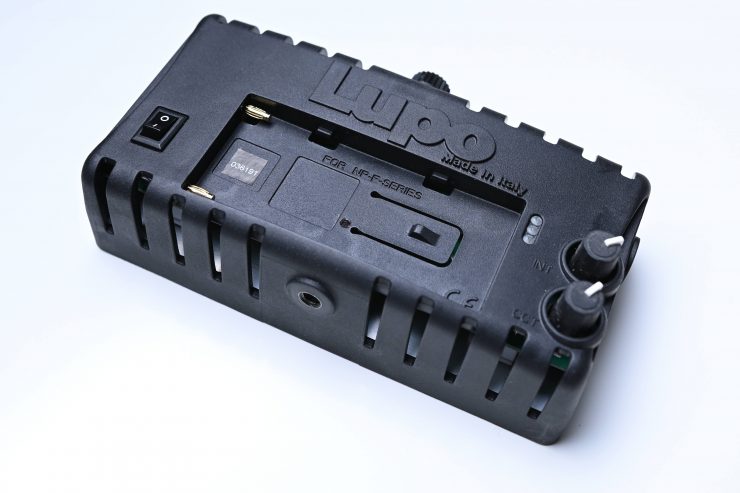
The Smartpnael looks like most other on-camera style lights and there is nothing that makes it stand out.
Like all Lupo lights, they concentrate on form and function rather than flash. The Smartpanel has the same industrial style looking design as all Lupo lights. I don’t mind that Lupo does this, as you know what to expect when you buy one of their lights.
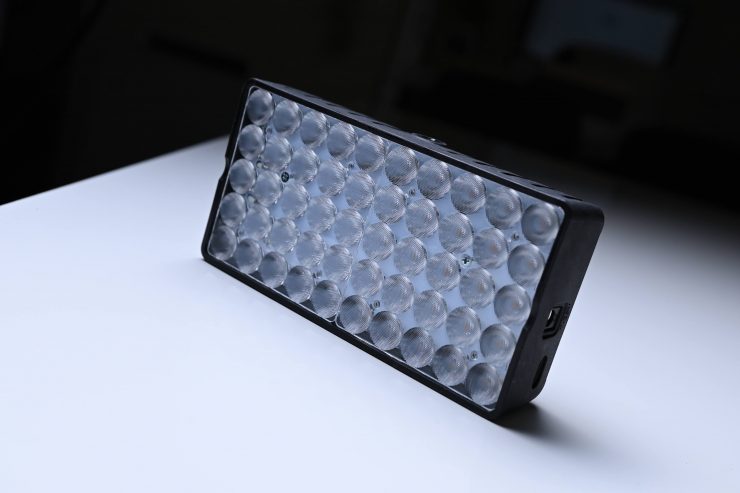
The casing of the fixture is made out of reinforced technopolymer and the light is nice and robust for a small on-camera fixture, despite only weighing 300g. It is matte black in color which is good because it doesn’t reflect any light. The only problem I found with the finish on the casing of the light is it is very prone to scratches. While this is more of a cosmetic issue, than a build quality issue, some potential buyers may not like this.
What do you get?
When you buy the Smartpanel you get with it the ball mount, the diffuser, and a USB Type C cable.
Batteries and AC/Adapter are sold separately. So is the D-tap cable.
Power Draw
The Smartpanel draws just 20W, which given the claimed output is impressive. This makes them a great choice for the travelling cameraman, or anyone who needs to run lights off batteries or USB power banks.
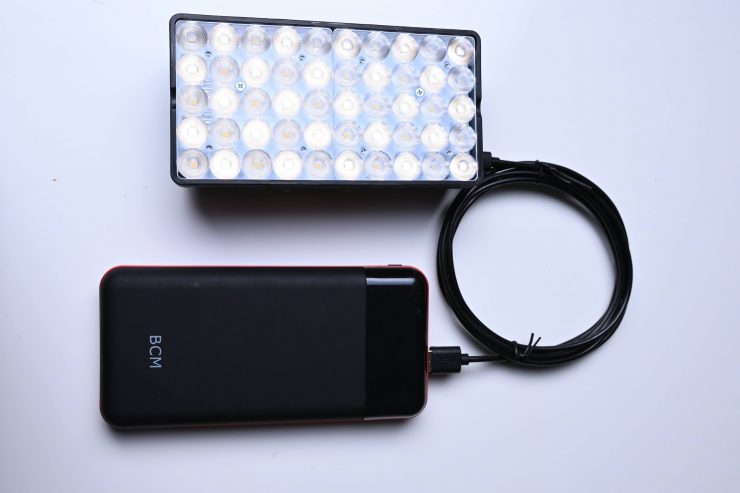
The Smartpanel can be mains powered or battery powered. There is also a USB Type-C cable for the power supply that is included in the package, but alternatively, you can also use common NP-F type batteries or an AC power supply.
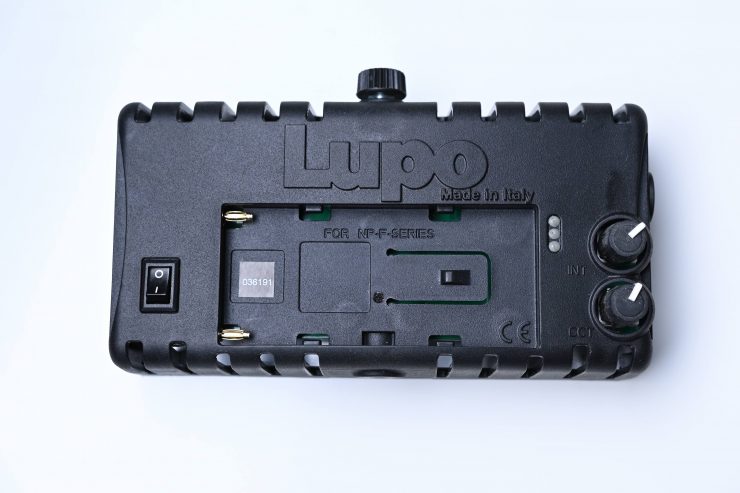
On the back of the light you can directly attach any NP-F-series batteries (7.4 V). These are super common batteries that you can find anywhere. If you want to run it off a larger battery you can do this is using a D-Tap cable.
Controls
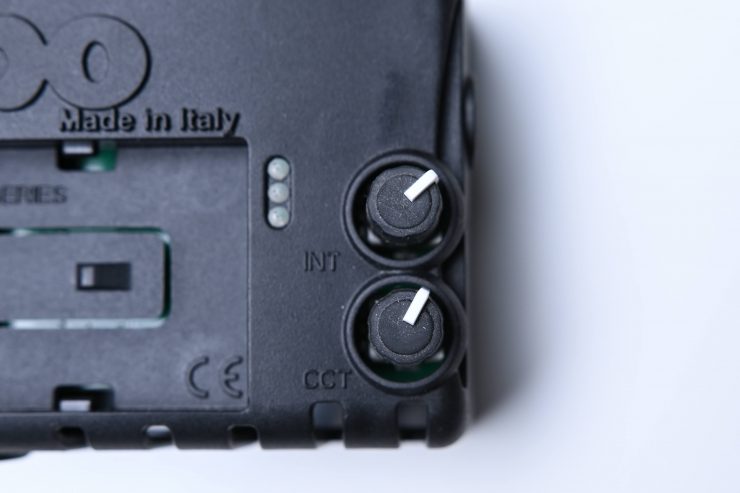
The controls on the Smartpanels are about as simplistic as you can get. There is an intensity dial, a Kelvin color temperature dial, and a simple on/off switch.
There is no display at all, except for three small LED lights that indicate battery strength. I would have liked to have seen a small LCD screen or even just some markings on the dials because you can’t tell what Kelvin color temperature you are using unless you are at 3200 or 5600K.
The intensity and color temperature dials are easy enough to use and reach, but they don’t have any notches and aren’t particularly tactile. In saying that, this has been designed as an easy to use light and because it is quite basic, users are unlikely to be making many changes to the light.
Mounting
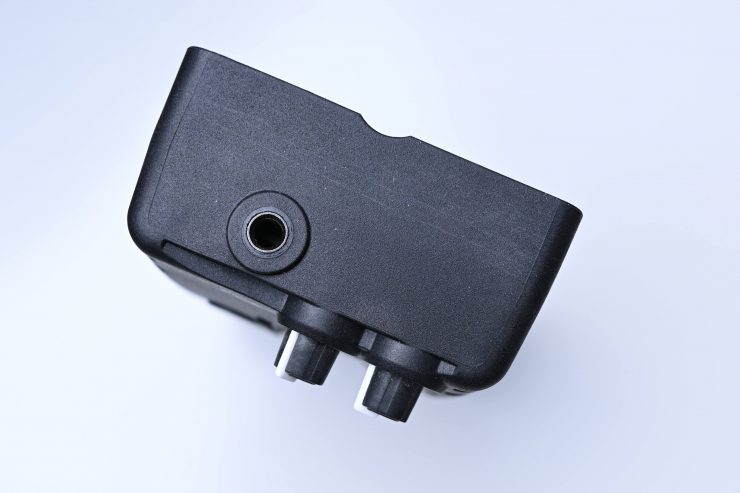
The light has 1/4 20″ threaded hole on the top, the bottom, and on the right-hand side of the light. I like that there are three mounting positions and not just one. This allows you to mount the light in a variety of ways depending on your needs.
Having multiple mounting points also allows you to connect multiple fixtures together to create a larger source.
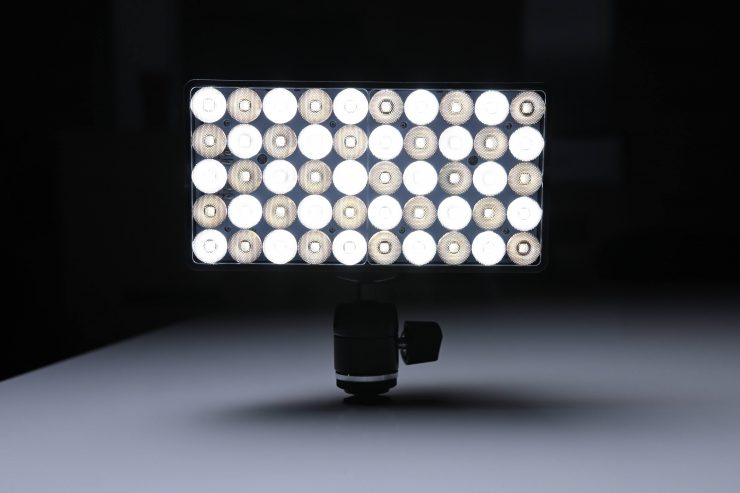
The light comes with a solid ball mount head that can be used on a cold shoe or light stand.
Diffusion Filter
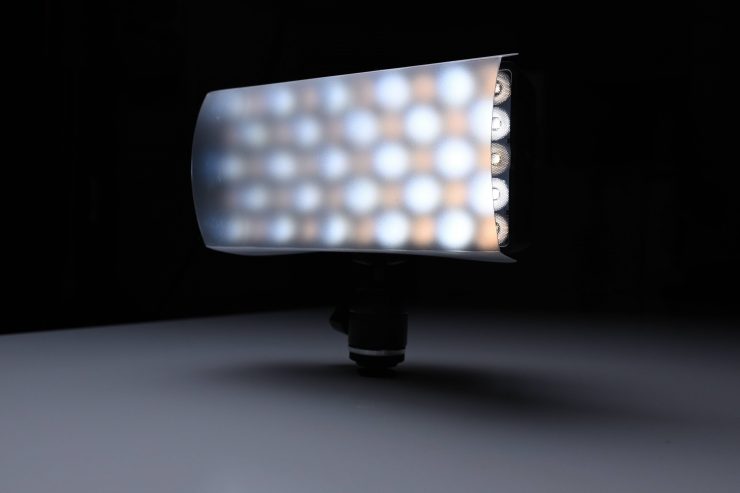
LUPO gives you an easy to use diffusion filter that screws onto the top f the fixture and then the other end goes between a light stand or the ball mount head.
This softens the light quite a lot. It is far from fancy, but it gets the job done.
No RGB
While a lot of smaller style lights are now RGB, Lupo has decided to stick with Dual Color for the Smartpanel. Given its intended purpose, this is probably the smart move.
To be honest, as the light is so powerful, you could just attach colored gels to the front of it if you needed to.
Beam Angle
The beam angle of the Smartpanel is quite narrow. It is 40 degrees, which is the same as the Actionpanels and some of the Superpanels.
On-camera style lights can vary tremendously when it comes to beam angles. Some have a quite narrow beam angle, and a lot of that has to do with the physical size of the fixtures, and others can have very wide beam angles.
In the case of the Cineo Matchbox, it has a beam angle of 140 degrees.
Photometrics
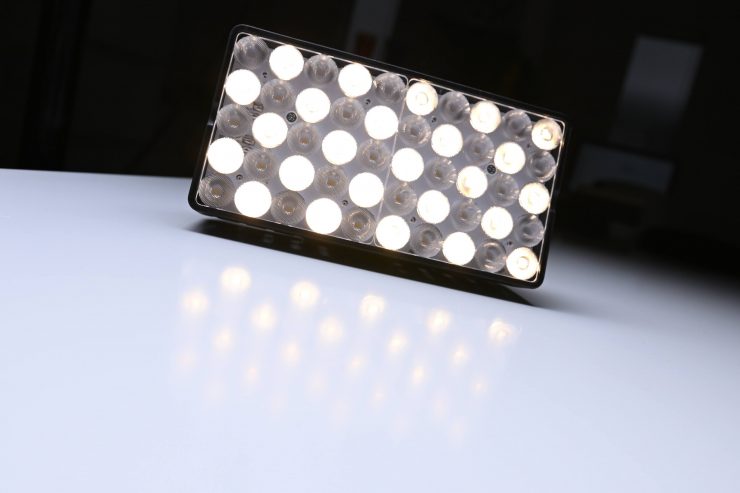
So now let’s get to the photometric results. I always test lights in this way so that I get a reference to how they compare to other fixtures. Results only tell part of the story and should never be used alone to judge a light. I have found from extensive testing over the years that certain lights that have good photometric results don’t always look good, and lights that have worse photometric scores can sometimes look better than their results indicate.
Output & Kelvin Color Temperature Accuracy
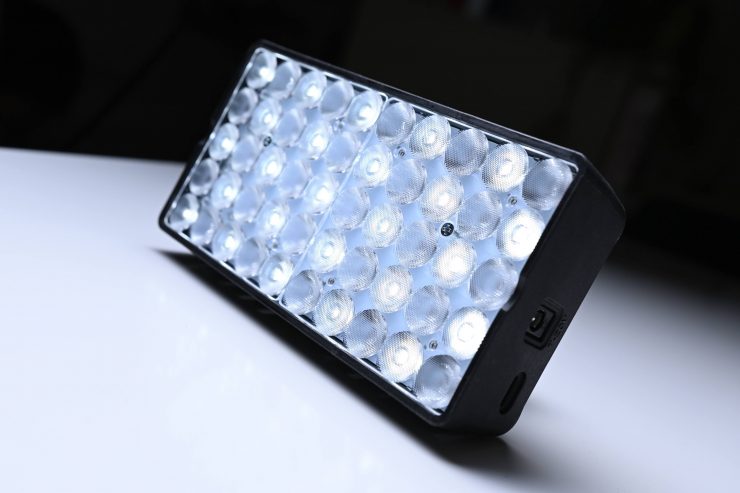
I tested the Lupo Actionpanel Smartpanel at a variety of Kelvin color temperatures with a Sekonic C-800 Spectrometer to find out how much output the light had and how accurate the Kelvin color temperature reproduction was. All readings are taken at a distance of 1m (3.28ft) in a controlled environment.
5600K
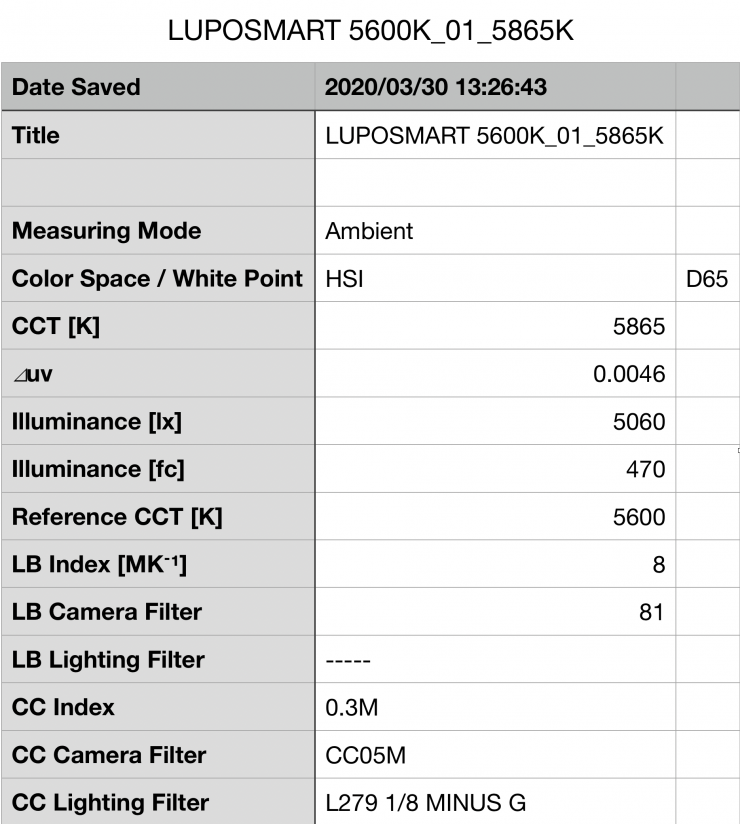
Above you can see the Smartpanel recorded an output of 5060 lx 470 (fc) when set at 5600K and run off a Sony NP style battery. This output was extremely impressive for a fixture of this size that only draws 20 watts. This tiny light has more output than a lot of 1×1 fixtures that I have tested.
I don’t know of any other light on the market that could produce this much output from a single small Sony NP style battery. What you do clearly need to remember is that the Actionpanel has a very narrow 40-degree beam angle.
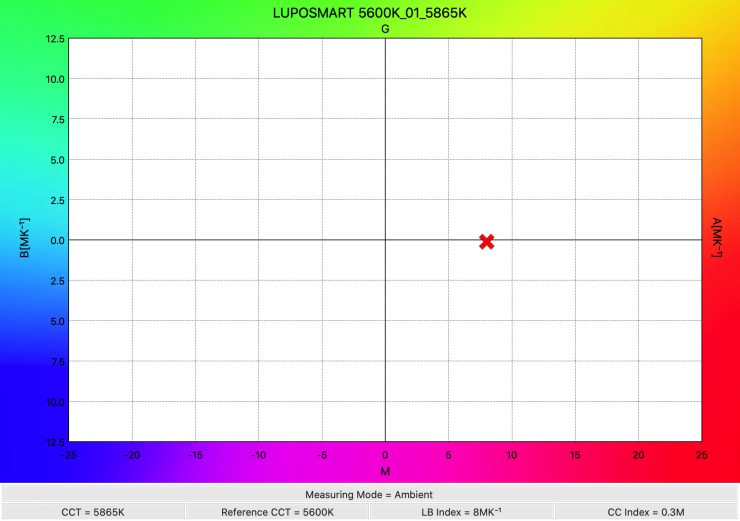
The Lupo produced a Kelvin color temperature of 5865K. The Smartpanelhad a 0.3G CC Index score. The 5865K reading was a little higher than what I would have liked to have seen, but it was still fairly accurate.
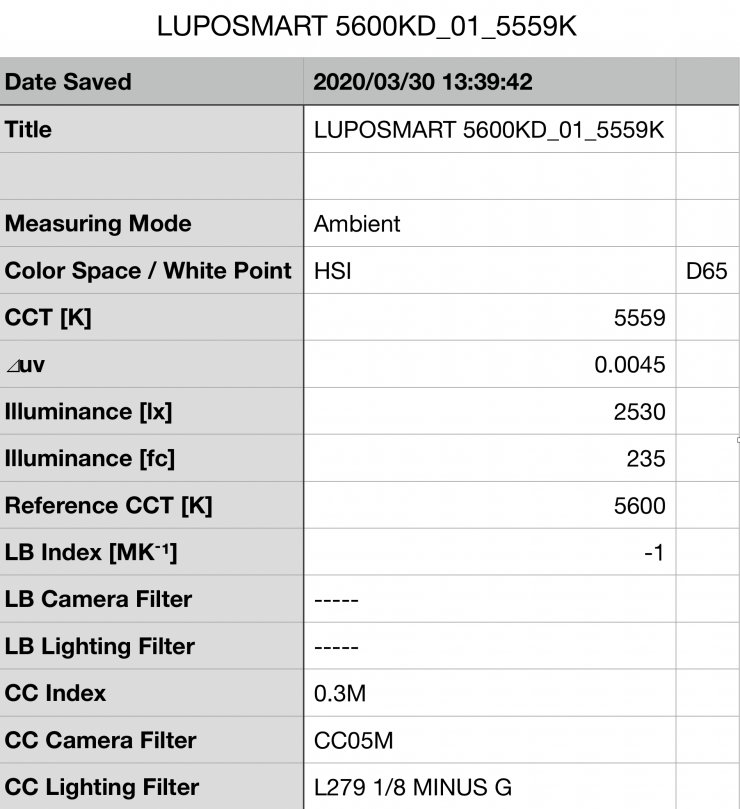
I also recorded figures when attaching the diffusion box. The Smartpanel recorded an output of 2530 lx 235 (fc) when set at 5600K and run off a Sony NP style battery. This was still an impressive figure for any light, especially one this small.
This was a decrease of exactly 50% when compared to not using the diffusion box.
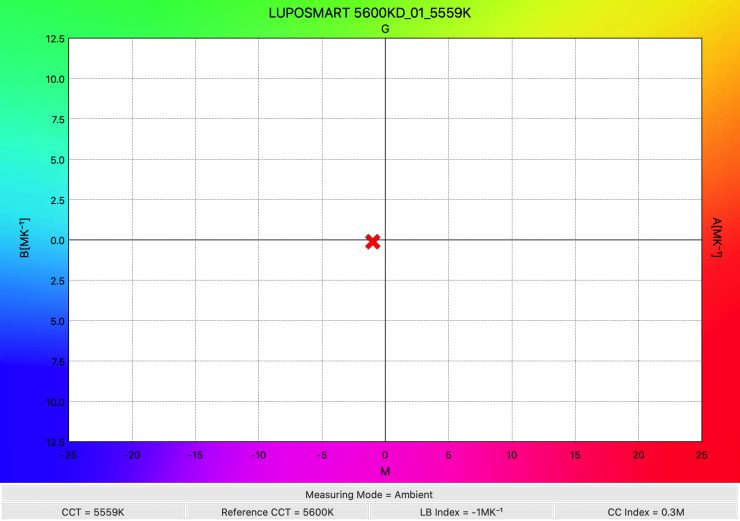
Interestingly enough the light recorded a better Kelvin color temperature of 5559K when using the diffusion box.
As a comparison, below is the LUPO Smartpanel compared to other on-camera lights (or lights that could be used in that capacity) that I have tested. I have also thrown in a few figures from 1×1 panels to you can also get a good guide as to how bright the LUPO is:
| OUTPUT | |
| LUPO Smartpanel Dual Color | 5060 lx |
| Cineo Matchbox | 346 lx |
| Lumos Trip Pro | 441 lx |
| Litepanels Luma | 1050 lx |
| Litepanels Sola ENG | 901 lx |
| Cineroid L10-C | 548 lx |
| Aputure MC RGBWW LED Light | 100 lx |
| Aputure Amaran AL-MX Bicolor LED Mini Light | 200 lx |
| Aputure Amaran AL-F7 On-Camera Variable Color LED Light (3200 to 9500K) | 1500 lx |
| Aputure Amaran AL-MW Mini LED Light | 300 lx |
| 16×9 HDV-Z96 | 577 lx |
| Rotolight NEO 2 | 1040 lx |
| Pilotfly AtomCube RX1 | 382 lx |
| Vibesta Peragos Bi-Color | 569 lx |
| Litepanels Astra 1×1 Bi-Color Soft | 3000 lx |
| F&V Z400S | 2250 lx |
| Litepanels Gemini 1×1 Soft | 6780 lx |
From this list, you can see just how ridiculous the output from this little LUPO light is. It is, however, important to remember that the LUPO has a very narrow beam angle compared to some of these other lights.
3200K
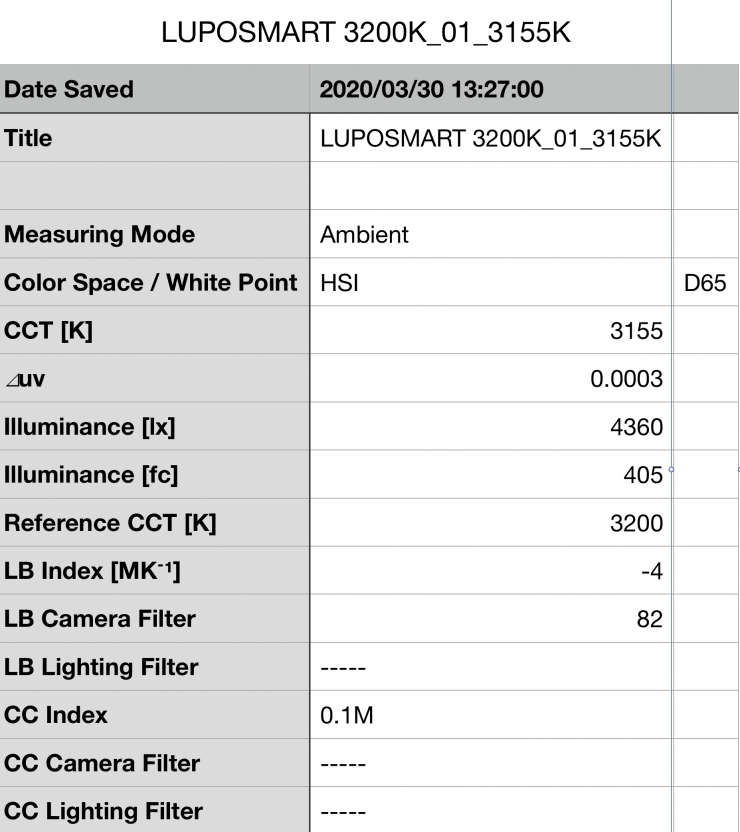
Above you can see the Actionpanel Dual Color recorded an output of 4360 lx 405 (fc) when set at 3200K and run off a Sony NP style battery. This was again, an extremely impressive figure for such a small light.
At 3200K it has just 13.8% less output than when used at 5600K.
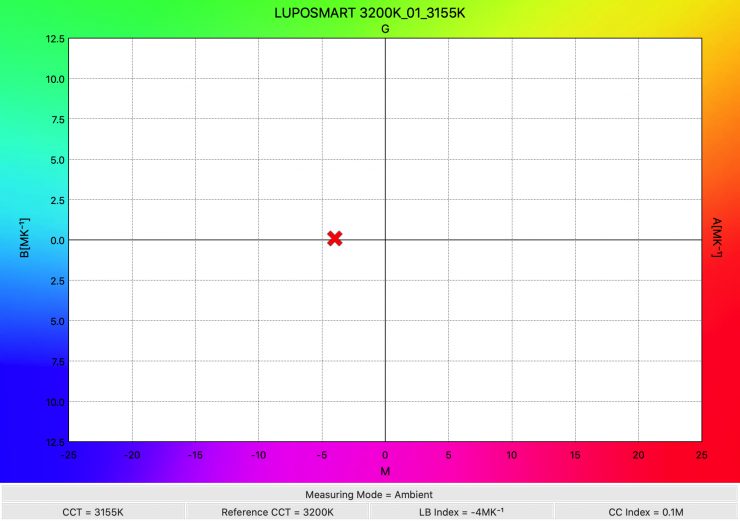
The light produced a Kelvin color temperature of 3155K. The fixture had a 0.1M CC Index score.
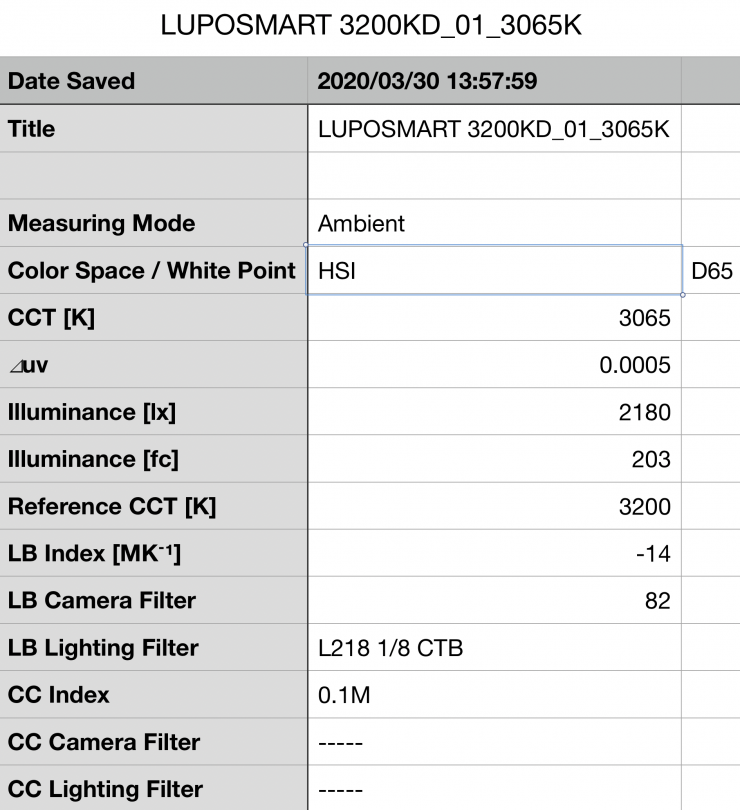
I also recorded figures when attaching the diffusion box. The Smartpanel recorded an output of 2180 lx 203 (fc) when set at 5600K and run off a Sony NP style battery.
As expected, this was exactly 50% less output than when the light is used without any diffusion.
Summary of output and Kelvin color temperature results of Actionpanel Dual Color (all results recorded at a distance of 1 meter):
| LUX | FC | Kelvin Color Temperature | |
| 3200K | 4360 lx | 405 fc | 3155K |
| 3200K (Diffusion) | 2180 lx | 203 fc | 3065K |
| 4400K | 3220 lx | 299 fc | 4337K |
| 5600K | 5060 lx | 470 fc | 5865K |
| 5600K (Diffusion) | 2530 lx | 235 fc | 5559K |
These results show me that the lights output only drops marginally when you use it at 3200K as opposed to 5600K. If you set it between 3200K and 560K the output will be lower because it is blending the LEDs to create that color temperature.
The output of the light is extremely impressive. The Kelvin color temperate accuracy of the light could be slightly better when it is used at 5600K. It is more accurate when set at 3200K.
Color Rendering
So now that we have seen how much output the Lupo Smartpnael produces, how does it perform when it comes to replicating accurate colors. Will the high output effect color rendering performance? Well, let’s find out.
5600K
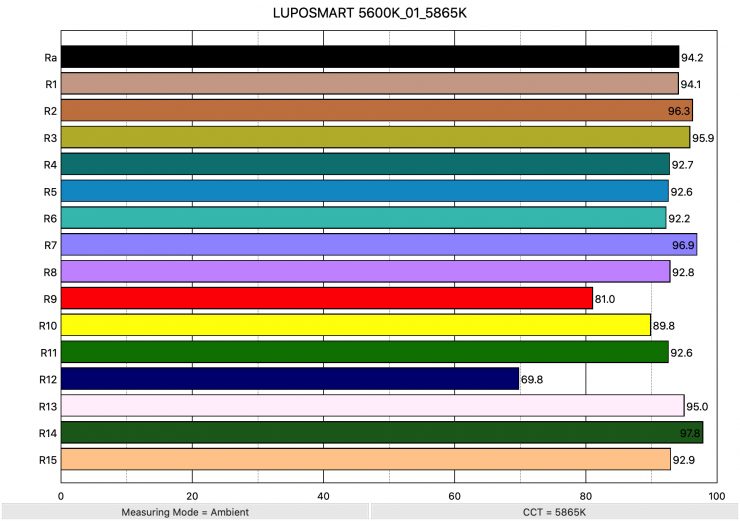
Above you can see that when the Dual Color was set at 5600K it recorded an average CRI (R1-R8) of 94.2 and an extended CRI (R1-R15) of 91.49. For replicating accurate skin tones it recorded 81 for R9 (red), 95 for R13 (closest to caucasian skin tones), and 92.9 for R15 (closest to Asian skin tones). These were all good results.
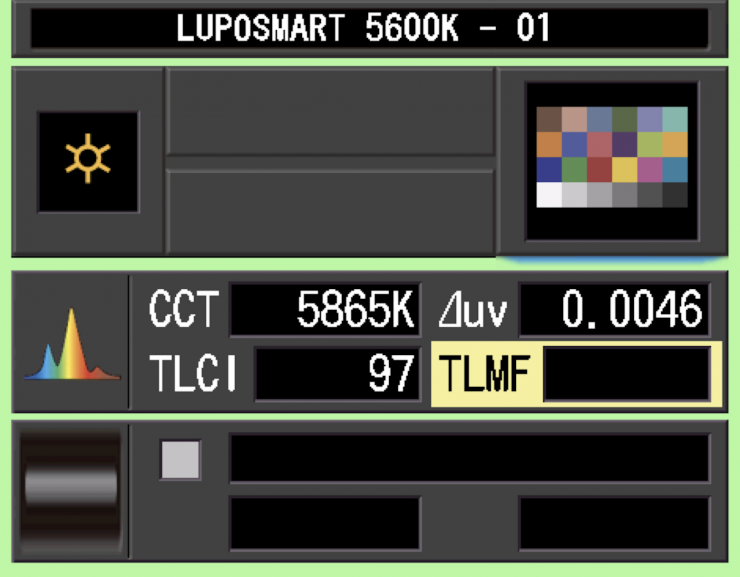
The light when set at 5600K also recorded a TLCI score of 97. In case you are not familiar, the TLCI takes a measurement of the spectral power distribution of a luminaire, using a spectroradiometer. It then analyses the performance of the luminaire in the context of television. It awards a single number value to the luminaire, on a scale from 0 to 100. The significance of the numbering is the same as the CRI, but with important differences. Unlike the CRI, where a score of greater than 90 is widely regarded as the minimum for television use, the TLCI-2012 scores are more spread out:
- 85 to 100: errors are so small that a colorist would not consider correcting them
- 75 to 80: a colorist would probably want to correct the color performance, but could easily get an acceptable result
- 50 to 75: a colorist would certainly want to correct the errors, and could probably achieve an acceptable result, but it would take significant time to get there
- 25 to 50: the color rendering is poor, and a good colorist would be needed to improve it, but the results would not be to broadcast standard
- 0 to 25: the color rendering is bad, and a colorist would struggle for a long time to improve it, and even then the results may not be acceptable for broadcast
With most modern day lights, they all score above 90. I still conduct these tests as it gives me a reference where I can then compare previous lights I have tested.
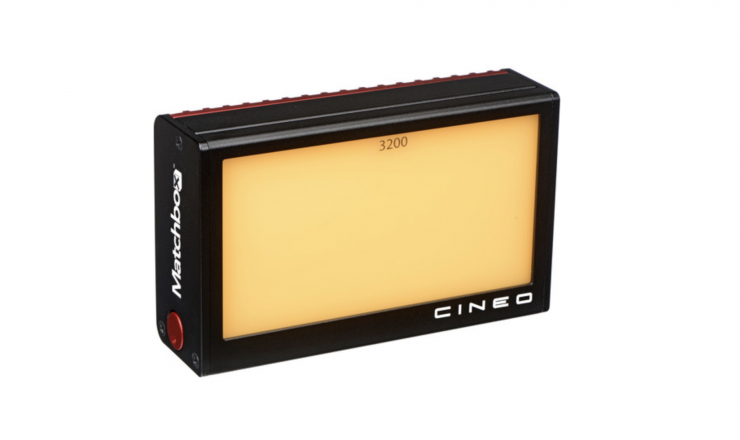
So how does the LUPO compare to a smaller sized on-camera light like the Cineo Matchbox (which I still regard as the gold standard for color accuracy amongst lights this size)?
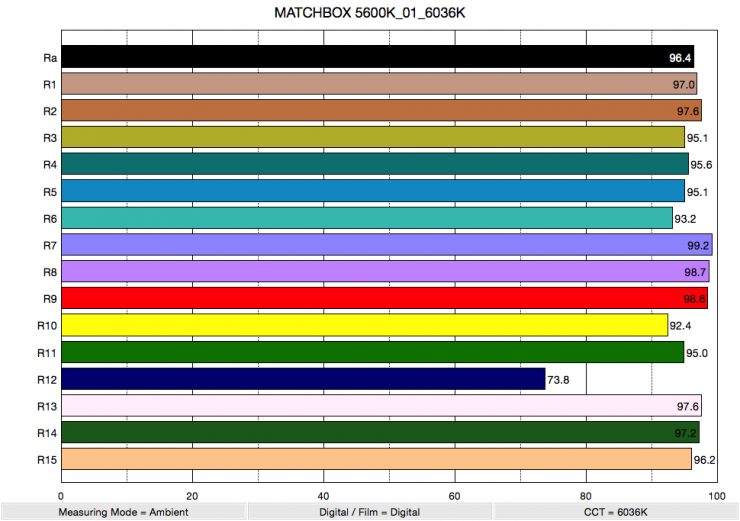
Well, above you can see the color rendering scores for the Cineo matchbox. The Cineo Matchbox, when used at 5600K, recorded an average CRI (R1-R8) of 96.4 and an extended CRI (R1-R15) of 94.82. For replicating accurate skin tones it recorded 96.6 for R9 (red), 97.6 for R13 (closest to caucasian skin tones), and 96.2 for R15 (closest to Asian skin tones).
The Lupo isn’t quite as good as the Cineo at 5600K, but it does still produce good results.
3200K
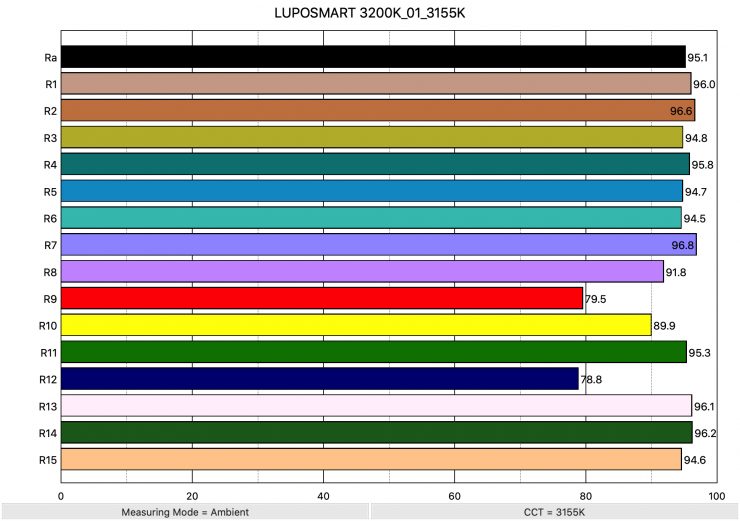
Above you can see the scores for Smartpanel when it was used at 3200K. It recorded an average CRI (R1-R8) of 95.1 and an extended CRI (R1-R15) of 92.76. For replicating accurate skin tones it recorded 79.5 for R9 (red), 96.1 for R13 (closest to caucasian skin tones), and 94.6 for R15 (closest to Asian skin tones). These results were pretty good, but the scores for R9 and R12 could be higher.
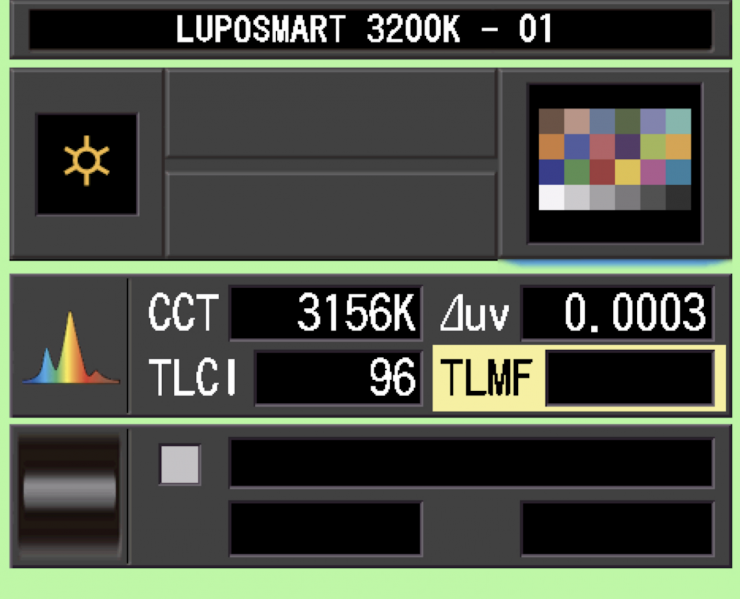
The light when set at 3200K recorded a TLCI score of 96.
So how does the LUPO compare to the Cineo Matchbox?
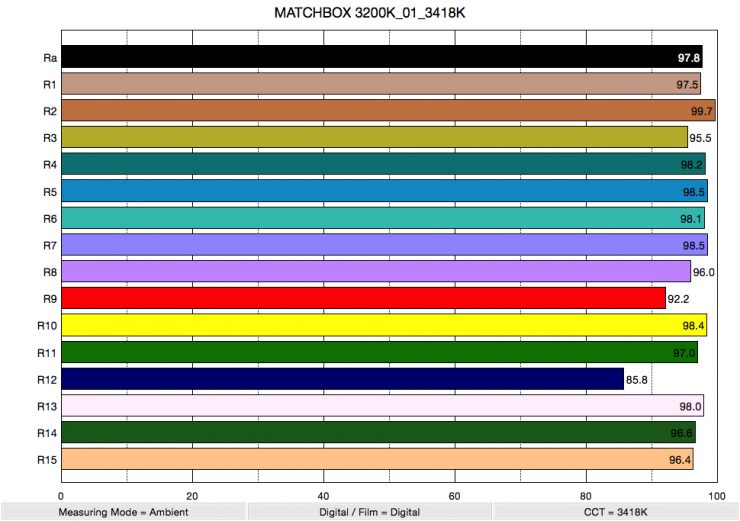
Well, above you can see the color rendering scores for the Cineo Matchbox. The Cineo Matchbox, when used at 3200K, recorded an average CRI (R1-R8) of 97.8 and an extended CRI (R1-R15) of 96.43. For replicating accurate skin tones it recorded 92.2 for R9 (red), 98 for R13 (closest to caucasian skin tones), and 96.4 for R15 (closest to Asian skin tones).
The Lupo isn’t quite as good as the Cineo at 3200K, but it does still produce good results.
SSI
SSI (Spectral Similarity Index) was developed by the Sci-Tech Council of the Academy. SSI gives me the ability to set any light as a standard, or use predefined standards (such as CIE D55), and then give other lights an SSI score based upon how well they will match standards such as CIE D55 measure spectral response and compare it directly against an ideal light source.
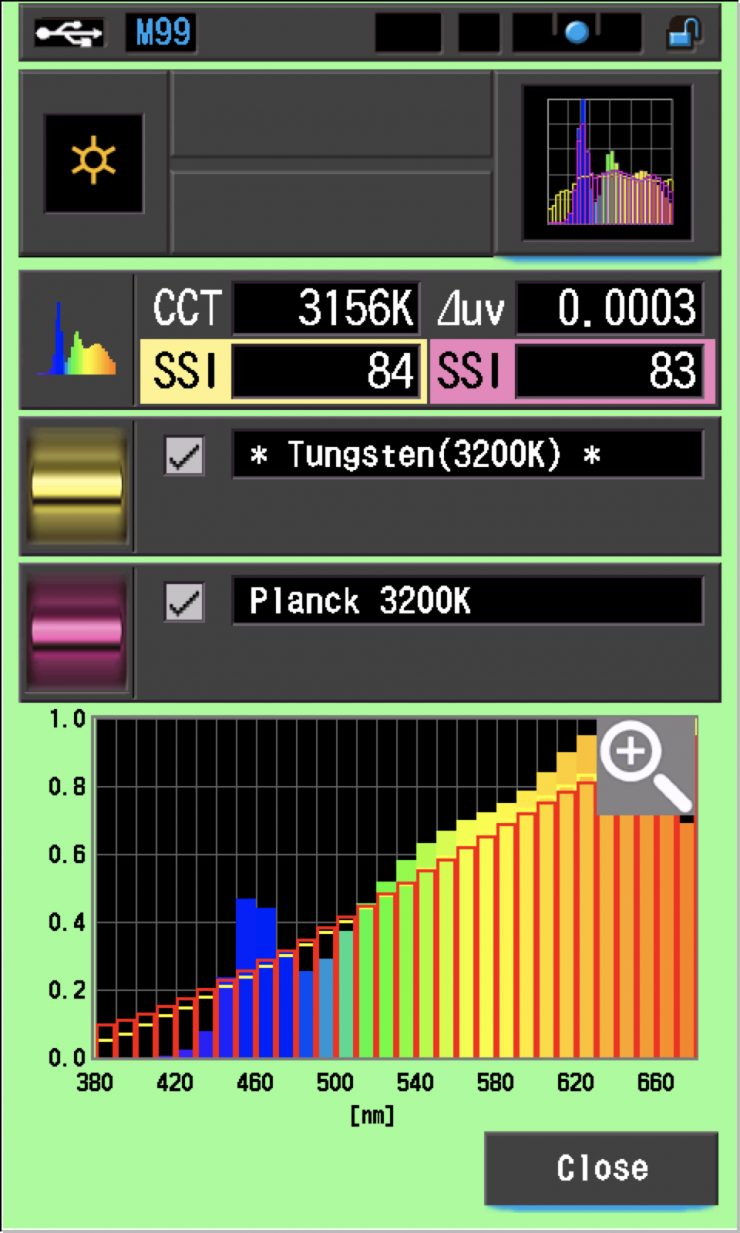
In this graph the Gold bars indicate a perfect 3200 (Tungsten source. The Red bars indicate a Planck 3200K source. This lets us compare how close to a perfect 3200k lighting source the Lupo is. A score in the low to mid-80s is very good for a 3200K LED light.
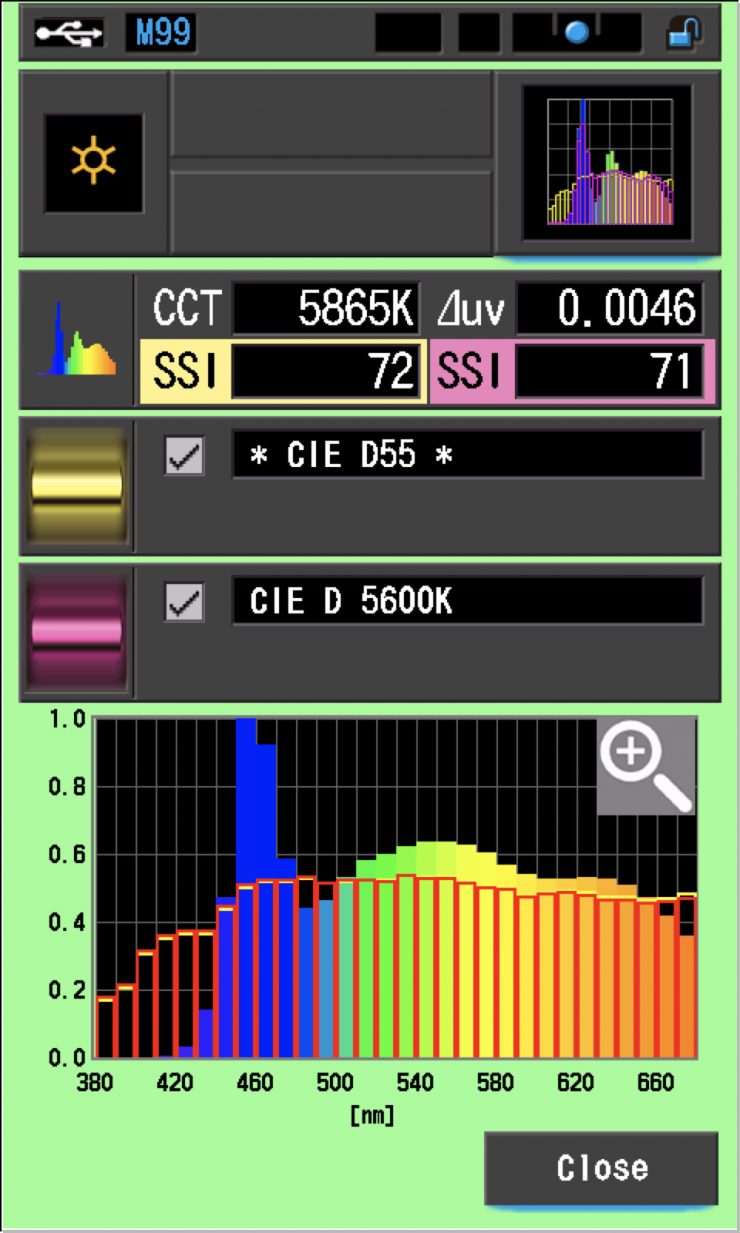
In this graph above the gold bars indicate a perfect D55 source. The Red bars indicate a 5600K source. This lets us compare how close to a perfect 3200k lighting source the Lupo is. A score in the low 70’s is very common for most 5600K LED sources.
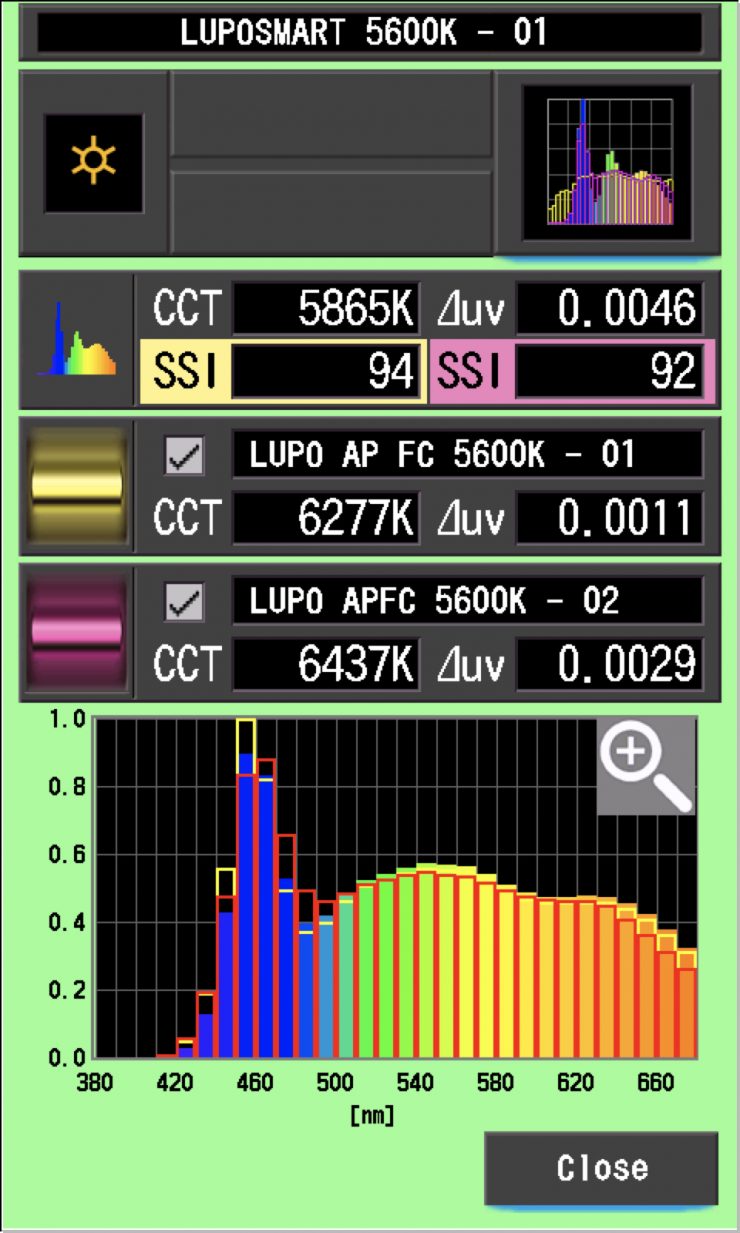
The main reason we want to record SSI scores is so we can see how well they match with other lights. I was curious to see how well Lupo’s Smartpanel Dual Color would match when used with their Actionpanel Dual Color and the Actionpanel Full Color at 3200K and at 5600K.
At 5600K, the Smartpanel Dual Color, Actionpanel Dual Color, and Full Color fixtures are not quite a match, but a score in the 90s’ means you could easily use them together without noticing much difference.
At 3200K the Smartpanel Dual Color, Actionpanel Dual Color, and Full Color fixtures are a closer match. You could use all three of these lights at 3200K and they would all look very similar.
Spectral Distribution
5600K
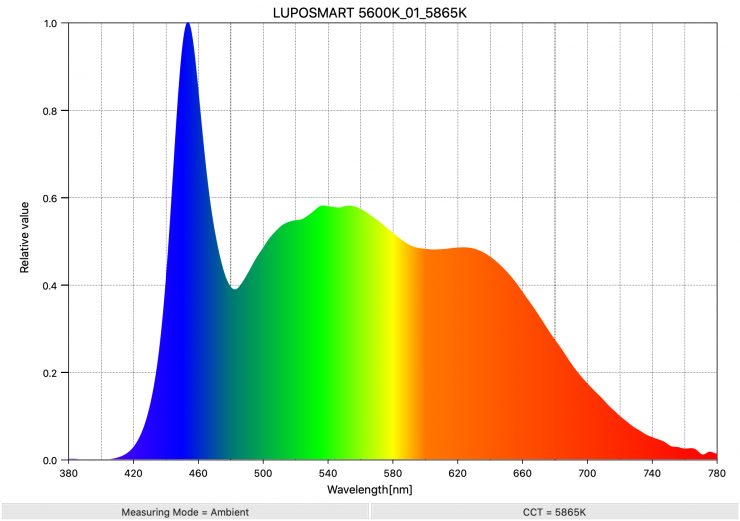
Above you can see the spectral distribution of the Dual Color when it is set at 5600K. The spectral distribution is fairly good at 5600K and the light only has a marginal green spike. This spectral distribution is fairly common for a lot of LED lights at 5600K.
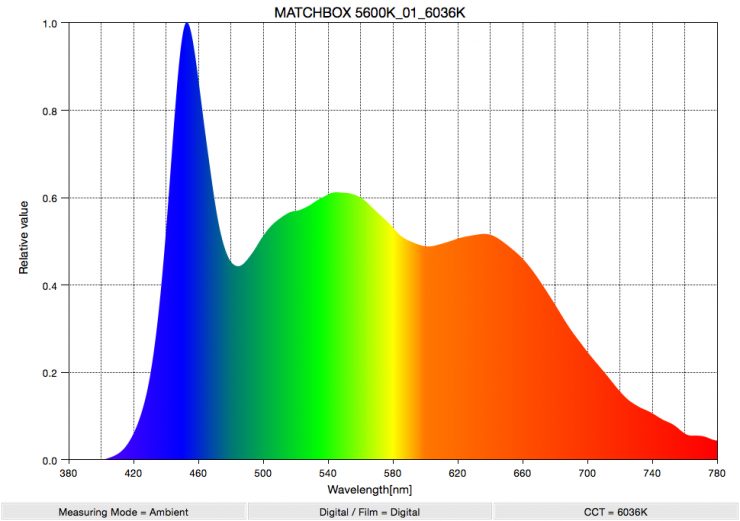
As a comparison, above you can see the spectral distribution of the Cineo Matchbox when it is set at 5600K. As you can see the Cineo has a very similar spectral response to the LUPO.
3200K
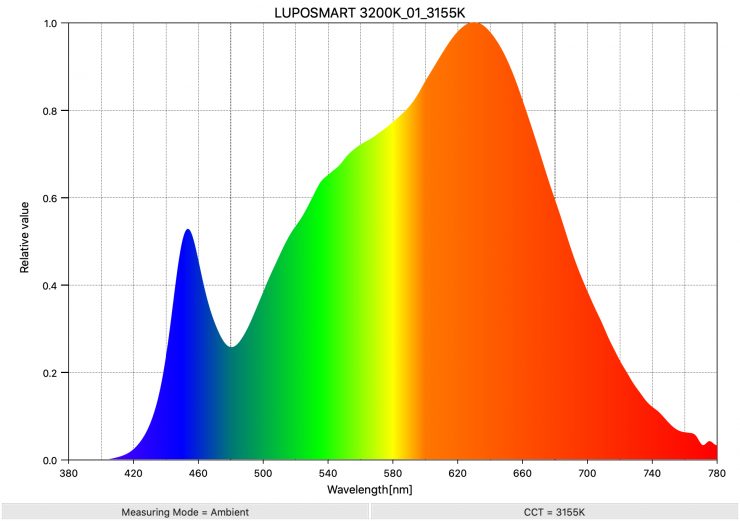
Above you can see the spectral distribution of the Smartpanel when it is set at 3200K. The spectral distribution is excellent at 3200K and the light doesn’t have any spikes where it shouldn’t. This spectral distribution is very good for a LED light at 3200K.
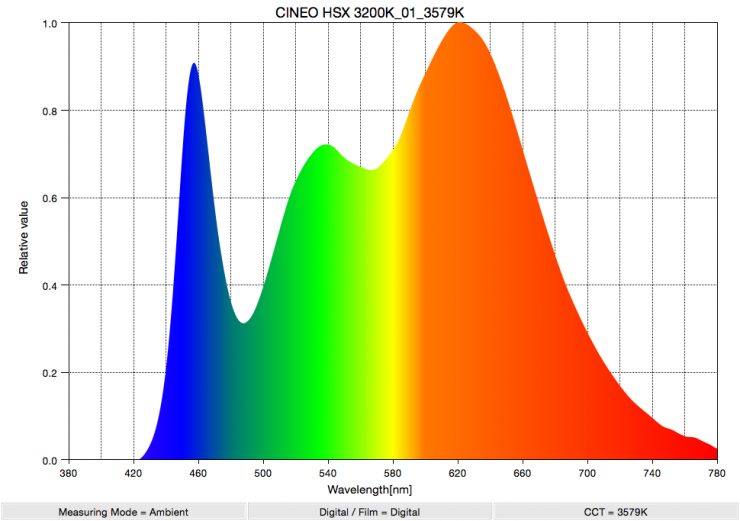
As a comparison, above you can see the spectral distribution of the Cineo Matchbox when it is set at 5600K. As you can see the Cineo doesn’t have as good spectral distribution as the Cineo.
Now, the Cineo is an older light, but it is interesting to compare the two lights.
Real World Performance and Quality of Light
As I always say, photometric scores only tell you part of the story. So how do the scores from the LUPO Smartpanel translate into real-world performance?
I found the LUPO to be a very versatile light and one that I can just keep in a bag for situations when I need some light, but I don’t want to carry around or have to pull out a larger fixture.
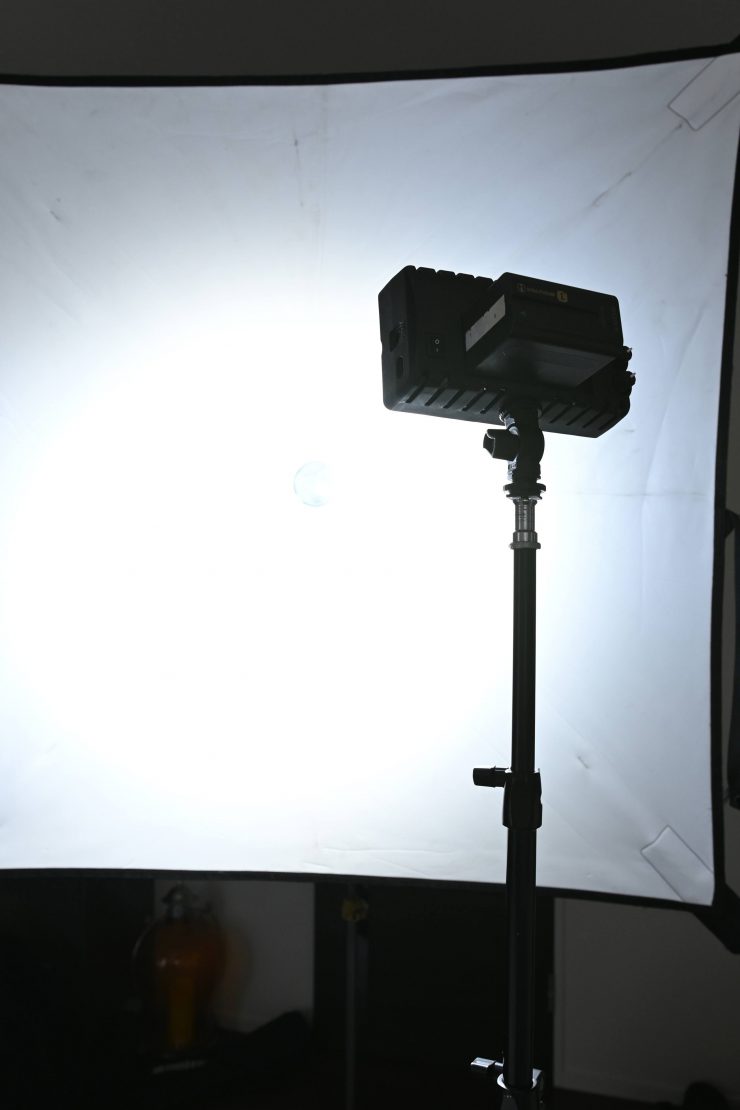
It has enough output that you can use it through diffusion or even punch it into a bounce board or reflector if you want a softer source.
It even has enough punch that you can direct it into a ceiling or wall in a smaller sized room when you just need to lift the levels up.
As the light has such good output, you can very easily use it as a key light. This is something you would struggle to be able to do with most on-camera lights.
Above you can see a comparison between the LUPO Smartpanel, Cineo Matchbox, and Vibesta Peragos Bi-Color. For this test, all the lights were in the exact same position and set at 5600K. The camera (in this case the Panasonic S1H) was pre-set to 5600K and the only variable being changed is the F-stop. The test is designed so that you can see the differences in output, beam spread, color rendition and the type of shadows you will get.
Please note that the camera wasn’t white balanced for each light, it was kept at 5600K.
From this short test, you can see the considerable difference in the f stop being used to obtain correct exposure between all three lights when they were all placed in the exact same position. Below is a summary of the F stops that we had to set when using the various lights:
| F/stop | |
| LUPO Smartpanel (no diffusion) | F/10 |
| LUPO Smartpanel (diffusion) | F/8 |
| Vibesta Peragos Bi-color (no diffusion) | F/6.3 |
| Vibesta Peragos Bi-color (diffusion) | F/5.6 |
| Cineo Matchbox | F/4 |
Without doing a white balance on the camera and having it preset to 5600K you can see that the LUPO leans slightly towards green, the Vibesta towards magenta, and the Cineo is the most color neutral.
In a real-world scenario you would white balance for the light you were using. This test is to show you how the lights behave when the camera is set at 5600K.
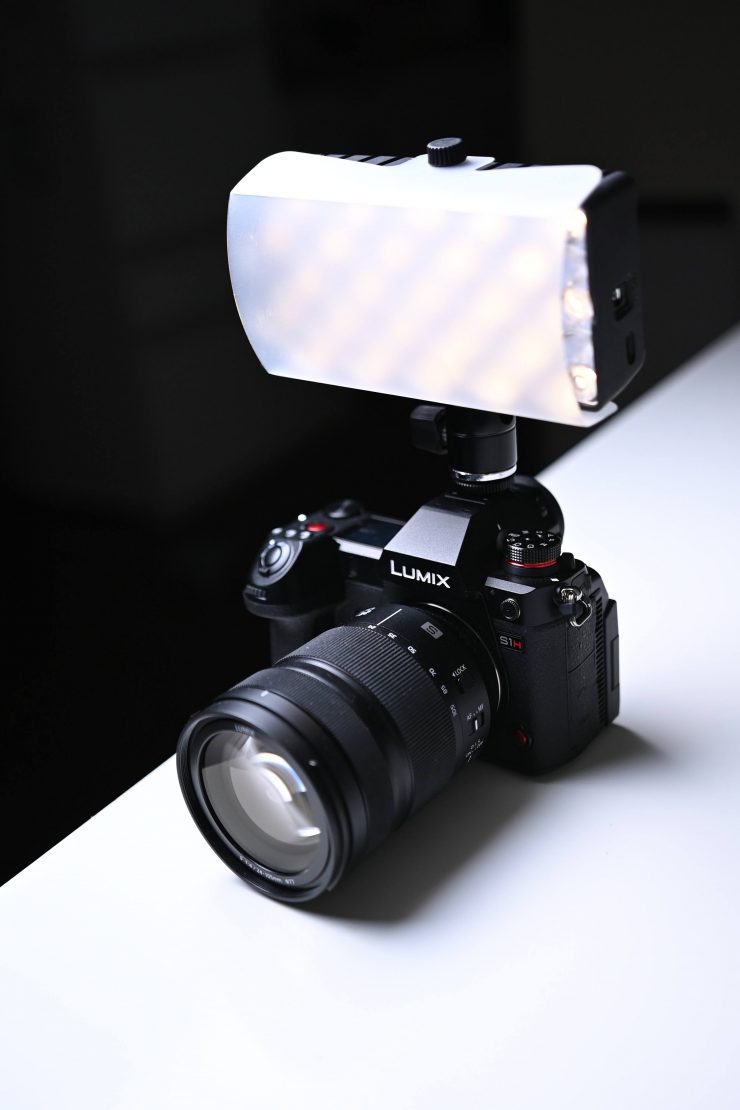
The light certainly works well as an on-camera light as well, but I almost found it to be too bright! That is something I never thought I would be saying about an on-camera light. You really do need to use the diffusion when you use it on camera and dial it down a little.
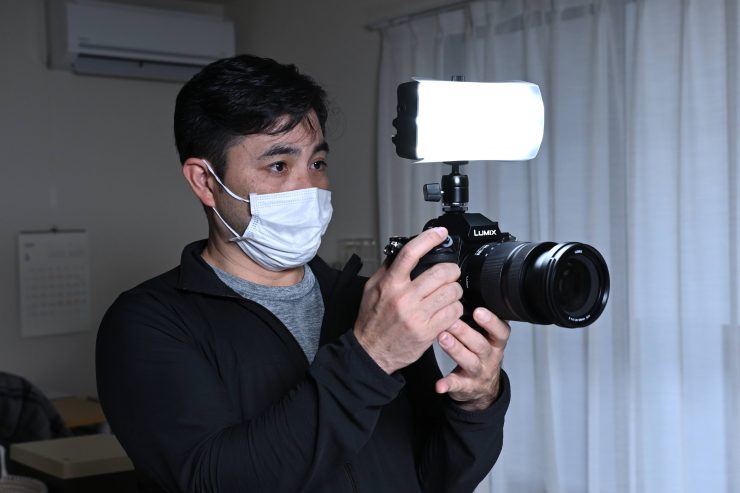
This allows you to create quite a nice soft source, but I would go a step further and actually use some more diffusion to make it even softer. This way you can create an on-camera light that is soft, but still bright.
Price
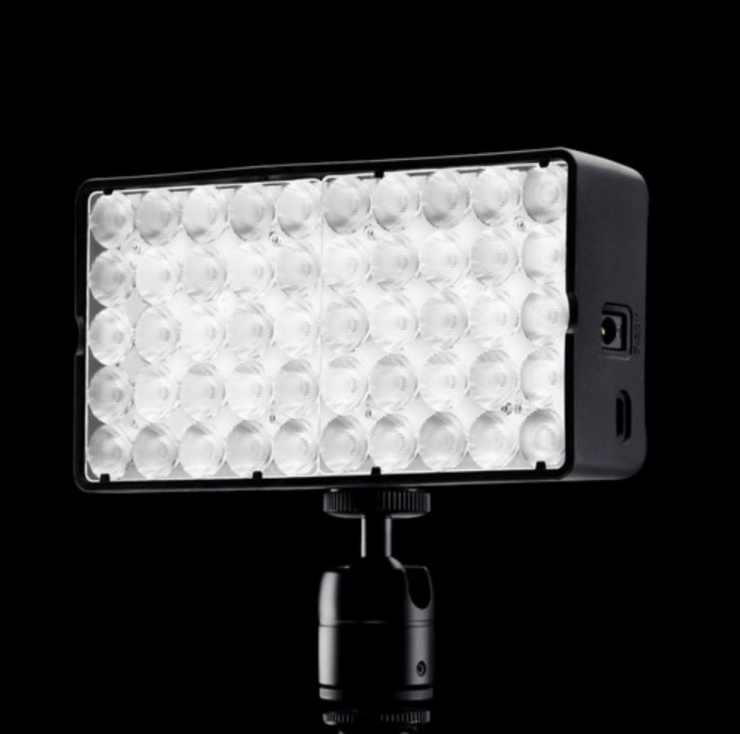
The Lupo Smartpanel retails for $159 USD. This makes it a very cost-effective lighting solution for anyone on a budget. At $159 USD this light is a bargain for what it is. Try finding another color-accurate light that draws just 20W and has the amount of output of the LUPO. Good luck, because you won’t find one.
I would like to see LUPO make a three-light kit and also a kit that combines a couple of Actionpanels and Smartpanels together.
You could of course just buy the lights separately and make your own kit, but it would be nice to have dedicated options.
Competition
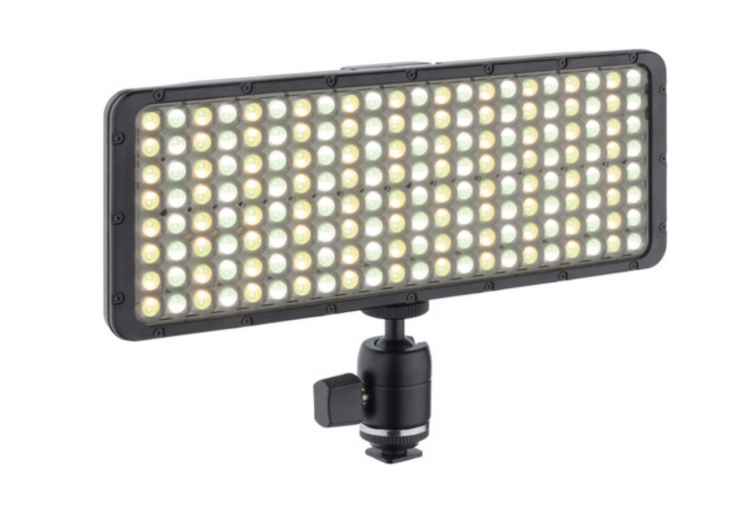
There area ton of on-camera style lights on the market but in my opinion, there isn’t anything that could be compared as direct competition, especially at this price.
There is also nothing on the market that comes even vaguely close to replicating the same amount of output in this form factor.
Here are some other on-camera lights that you could also choose from:
- Genaray LED-7100T 312 LED Variable-Color On-Camera Light $128.95 USD
- VariZoom Cineo Matchbox On-Camera RPT Light with Shoe Mount $399 USD
- Sony HVL-LBPC LED Video Light $549.95 USD
- Genaray LED-2100 36 LED Compact On-Camera Light $38.95 USD
- Rotolight NEO 2
- Vibesta Peragos Bi-Color $169 USD
- Aputure Amaran AL-F7 On-Camera Variable Color LED Light $98 USD
- Core SWX TorchLED Bolt 250W On-Camera Light $189 USD
- Aputure MC RGBWW LED Light $90 USD
- BOLING Pocket LED RGB Video Light $145 USD
- ikan Onyx 120 Bi-Color On-Camera LED Light $79 USD
- Luxli Cello 10″ On-Camera RGBAW LED Light Kit with Diffuser $378.99 USD
- LITRA LitraPro Bi-Color On-Camera Light Kit with Softbox $249.95 USD
Conclusion
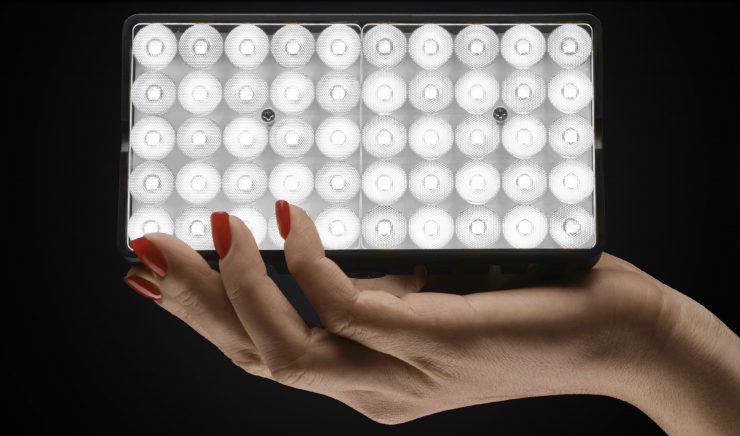
The LUPO Smartpanel exceeded my expectations. If you are looking for an on-camera light, or a small, power-efficient, battery-operated fixture then this light is very hard to overlook.
Most on-camera style lights lack output and can only be used for one purpose. With the LUPO you get a light that is powerful enough that you can use it for multiple applications. This is its greatest strength.
You have heard that expression that you can’t have your cake and eat it too, well LUPO gives you the cake, lets you eat it and then go back for seconds.
The only real caveat with this light is the narrow beam angle, but it is powerful enough that you can bounce it or put it through diffusion to create a larger source.
It is a great alternative for anyone who has to travel with lights and use them in locations where mains power may not be an option and space is at a premium.
The Smartpanels are functional and efficient. They get about their job with minimal effort. They are quick to set up and easy to use. When you don’t have a lot of time for lighting then you need tools that help you get good results without eating into your shooting time.
Lupo continues to do an outstanding job with its product range, and the Smartpanel just adds to that legacy.
With ridiculously high output, a low power draw, and a small footprint, this light is definitely worth having in your kit.

